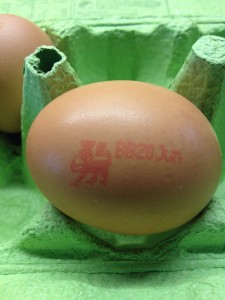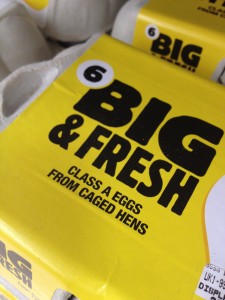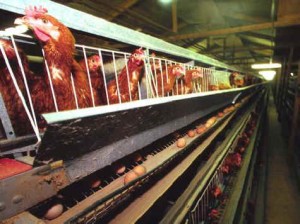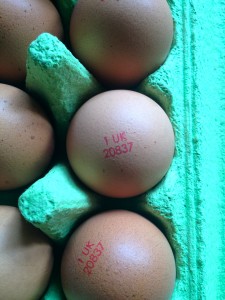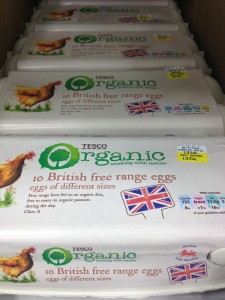As I have mentioned in earlier posts, on each store bought egg there is a Lion Brand Stamp. This means the egg is produced in a place that has vaccinated its hens against salmonella and also tells you something about the way the hen is being treated. Just to the right of the stamped Red Lion is a number, each indicating the farming method:
The hen house conditions for barn hens are set by the EU Welfare of Laying Hens legislation and stipulate a maximum stocking density of 9 hens per square metre of useable area (which is still pretty crowded btw – MB). Hens must be provided with nest boxes. Adequate perches, providing 15 centimetres of perch per hen, must also be provided. Litter must be provided, accounting for one-third of the ground surface – this is used for scratching and dust bathing.
The RSPCA agree that this is generally ok and allow their Freedom Food logo to be used on these eggs but it’s hardly ‘freedom’ is it? Well, it’s definitely a step up from the cages and at least there can be some perching and dust bathing and the multi-tiered barns allow for some up and down flying too. However, critics say the birds are trampling about in their own waste products, stressed by overcrowding, disorientated by the artificial light and never take in a scrap of fresh air their whole lives. The birds are stuffed together and still fed continuously for maximum egg production so does the chance of spending a few moments on a 15cm perch really equate to adequate conditions for the hens and does it therefore make for good healthy hens and eggs?
Further to this, it seems that the next level of egg production, labelled ‘Free Range’ and stamped with the number 1, is only the barn version but with ‘access’ to outside space during the daylight hours. There’s a hitch here straight away. Hens are naturally not keen on going out into wide open spaces as they fear aerial predators. The British Lion Code legislation requires vegetation (ground) and outdoor shading or a veranda (for those Tennessee Williams style hens that want to sit rocking in a porch swing smoking a cheroot) but hens prefer overhead covering to their vegetation (so they can feel safe scratching about for insects and dust bathing) so they tend NOT to go out of the pitifully few and small portals (ironically called ‘pop-holes’) that are provided and remain in the barn…so essentially a barn hen with a bigger price tag. Are these eggs producers likely to create safe outside spaces for their hens? No, of course not, it wouldn’t be economically viable to them I suspect…right? And hens shouldn’t smoke anyway…naughty hens…
Critics further slam (‘slam’ is so tabloid isn’t it?!) these methods by pointing out that the hens spend an inordinate amount of time subsequently jostling with each other inside rather than risk the outside and continue to bully, and even cannibalise, each other (so often have part of their beak removed – not very ‘free’ range is it?) not to mention wading through their own waste products which can lead to ammonia burns. Hmmm…not so good huh?
The ‘Organic’ eggs stamped with the number 0 are the same as Free Range but with legislation governing the soil and feed. Both these have to be certified as organic to meet the EU and British Lion Code standards. I think it’s telling that the organic standards are the EU stipulated ones (although be aware that many other countries in the EU have yet to comply with the EU laws governing caged hens so…) but the Lion Code people add a further stipulation, rather smugly I feel, ordering the ‘pop-holes’ for organic hens be larger. But this is admitting that the other hens are having to ‘pop’ through an inadequate hole isn’t it?! Oooh we’ve made their access to the outside world, fresh air, sunlight and chance to display natural habits (and the smoking veranda no doubt) bigger! Aren’t we just the nicest? Don’t you just love us now? And you don’t really mind us charging you more for that either do you? Ahhh thanks mugs…er…we mean, thanks lovely consumers…
Ok sarcasm is the lowest form of wit (but the hardest to master…) and I think you get the point. Is it a scam? Are we being jipped? Incidentally, I like the fact that the organic eggs pictured above say ‘eggs of different sizes’. Naturally hens lay different sized eggs and usually never the ‘large’ variety unless forced…the size (in this case) does not matter. Large eggs are only used in recipes as a failsafe and a medium, more naturally sized egg (at least for the hens ‘vent’ – don’t get a visual), is perfectly adequate. Think on…anyhoo I digress…
Also – farm shop eggs and farmer’s markets don’t have to be stamped as they operate outside the British Lion Code system so check with them that they are not just caged hens.
Only a small percent of eggs come from a barn or organic system in this country the majority being ‘colony’ ‘enriched cages’ and ‘free range’. Half the eggs produced in this country come from the caged systems. The supporters of ‘colony’ eggs (enriched cages) will talk of the better stability for the hen and that cages allow for their waste to be carried away and how they can control all the elements and create a consistent product, even boasting that the yolks are naturally coloured (from Maize) BUT isn’t it the unsettling nature of the system that means we should choose the eggs from the freer, less ‘treated’, less stressed hens? And some ‘experts’ argue that the nutritional value between caged soya etc fed hens and organic is marginal. But this is like eating fortified flour or cereals – the natural version of a vitamin is the best and a synthesised version is an isolated fake one that has MUCH less benefit. DO NOT be fooled! Vitamins and minerals work in groups and with a natural synergy, they depend upon each other in fact! I almost ‘shouted’ that last bit…I’m getting over excitable in my old age…
So you could argue that none of this is ideal. There is clearly room for improvement all round and in every system of egg production, but until that happens I’d say avoid caged hen products as much as possible, don’t you think? The price difference for better quality and more humanely produced eggs is around 25% more but even at this slightly higher price they are an excellent source of high quality protein (again, you get out of the egg what has been put into it…good or bad) and much cheaper than most other sources like meat – and worth it – especially as both the health of the hen and your health are at stake.
